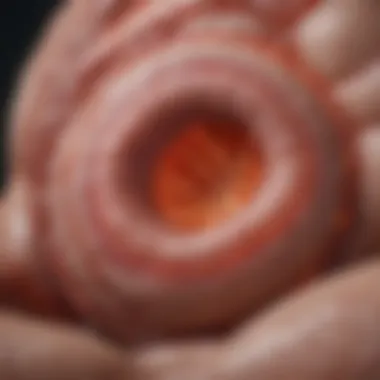Understanding Septic Bursitis: A Comprehensive Overview


Intro
Septic bursitis is an often overlooked, yet significant, medical condition characterized by the inflammation of bursa sacs, typically due to bacterial infection. Bursa are small, fluid-filled sacs located throughout the body, particularly near joints. They act as cushions between bones and soft tissues, reducing friction and allowing for smooth movement. Inflammation of these structures can lead not only to physical discomfort but also to functional limitations.
Bursitis can arise from various factors, including trauma, prolonged pressure, and of course, infection. Septic bursitis presents with unique challenges as it involves an infectious process, which complicates diagnosis and treatment. Recognizing the symptoms early can help prevent complications, so understanding this condition is crucial for both patients and healthcare providers.
This article lays out a comprehensive overview of septic bursitis, exploring its etiology, symptoms, diagnosis, treatment options, and prevention measures. The goal is to merge clinical insights with practical guidelines for a better understanding of this medical condition, applicable to students, researchers, educators, and professionals. As we delve deeper into the subject, we aim to provide clarity on a condition that, while frequently disregarded, can impact quality of life significantly.
Background and Context
Overview of the Research Topic
Septic bursitis is not merely an isolated ailment; it is part of a broader discussion on joint and soft tissue infections. Understanding this condition requires a grasp of anatomy and the physiological roles of bursa. When these structures become inflamed due to infection, the resultant pain and swelling can severely disrupt daily activities.
In recent years, awareness of septic bursitis has grown, particularly as we learn more about common pathogens, treatment resistance, and preventive strategies. The role of existing health conditions, such as diabetes, is becoming clearer, as they can predispose individuals to infection and contribute to poorer outcomes.
Historical Significance
Historically, conditions like septic bursitis have been documented for centuries, but modern medical approaches have transformed our understanding and management of the disease. Physicians in ancient times, for instance, relied on rudimentary knowledge of anatomy and rudimentary treatments. With advances in bacteriology and immunology, healthcare providers today are equipped with sophisticated diagnostic tools and treatment options.
Each case of septic bursitis may reveal varying underlying factors, and hence, this condition serves as a focal point for research into broader implications of musculoskeletal disorders.
Key Findings and Discussion
Major Results of the Study
A recent review of clinical cases has uncovered some pivotal insights. Notably, it has been found that early intervention is critical. Patients presenting with symptoms often bear the brunt of delays caused by misdiagnosis or lack of awareness about septic bursitis.
The review highlighted that commonly reported symptoms include localized swelling, redness, warmth around the affected area, and pain that can radiate to adjacent muscles or joints. These symptoms can mimic other conditions, leading to diagnostic challenges.
An analysis of risk factors indicated that certain groups, particularly the elderly, those with compromised immune systems, and individuals with a history of joint problems are at increased risk. Additionally, athletes and those engaged in occupations requiring repetitive movement (like laborers or musicians) are also more prone to develop this condition.
Detailed Analysis of Findings
In-depth evaluations reveal that septic bursitis usually requires medical intervention through antibiotic therapy and, in severe cases, surgical procedures to drain abscesses. Treatment protocols are evolving, with a focus on both pharmacological and non-pharmacological approaches. Research emphasizes the importance of individualized care plans based on patient history and lifestyle.
Preventive measures also play a pivotal role. Proper body mechanics, ergonomic work environments, and maintaining healthy skin can help mitigate risks. Awareness campaigns tailored for at-risk populations are being developed to educate about early detection and reporting of symptoms.
The findings drawn from recent studies underscore the importance of not viewing septic bursitis as an isolated instance, but rather as part of an interconnected framework of musculoskeletal health and disease management.
Understanding septic bursitis and its implications can greatly enhance patient outcomes and promote better quality of life.
This comprehensive exploration aims to bridge the gap between clinical knowledge and practical application, ensuring healthcare professionals are well-equipped to address the complexities associated with this condition.
Prelims to Septic Bursitis
The study of septic bursitis is essential for both medical professionals and patients. Understanding this condition aids in recognizing its symptoms, diagnosing it accurately, and implementing effective treatment strategies. Septic bursitis typically occurs when the bursa, small fluid-filled sacs that cushion bones and soft tissues, become inflamed due to infection. This can arise from various factors, including trauma, overuse, or direct infection from bacteria.
The significance of delving into septic bursitis lies in its potential impact on individuals’ quality of life. Patients may experience severe pain, swelling, and restricted movement. Thus, identifying this condition promptly can lead to better management and outcomes. Furthermore, exploring the broader implications of septic bursitis reveals insights into preventive measures and the importance of education surrounding this ailment.
In understanding septic bursitis, we can also appreciate the anatomy involved and how the bursa function as protective structures. This knowledge emphasizes the delicate balance within our musculoskeletal system and the consequences when this balance is disrupted.
Definition and Significance
Septic bursitis is defined as an inflammation of a bursa that is caused specifically by an infectious agent, most commonly bacteria. This condition can result in localized pain, swelling, and sometimes systemic symptoms, depending on the severity of the infection. Significantly, septic bursitis primarily affects areas that are subjected to repetitive stress or trauma. With instances of septic bursitis on the rise, understanding its definition becomes crucial in healthcare settings.
Infection within the bursa can lead to complications. This includes the risk of chronic bursitis or even septicemia if the infection spreads. Therefore, recognizing and diagnosing septic bursitis serves as a preventive measure against these potential complications.
The Anatomy of Bursae
Bursae are essential components of the human musculoskeletal system. They are small, sac-like structures that contain synovial fluid. Their primary role is to reduce friction between bones and surrounding tissues during movement. Each bursa is strategically located around joints, such as the shoulder, elbow, hip, and knee, providing cushioning during various activities.
Understanding the anatomy of bursae helps clarify why certain activities may predispose individuals to septic bursitis. Continuous friction or pressure can lead to microtears in the bursa, facilitating entry points for infectious organisms. In this respect, the health of bursae is vital for the overall functionality of our joints. When they become inflamed or infected, it illustrates the intricate relationship between structure and function in the body.
Bursae play a critical role in minimizing friction, supporting smooth joint movement, and absorbing shocks.
Etiology of Septic Bursitis


Understanding the etiology of septic bursitis is crucial in addressing the broader implications of this condition. The etiology encompasses the causes and risk factors that lead to the inflammation of the bursae, often due to infectious agents. Knowledge of these factors aids healthcare professionals in diagnosis, prevention, and effective treatment. Recognizing the relationship between specific pathogens and the resultant bursitis can lead to improved patient outcomes and more targeted therapeutic approaches.
Infectious Agents
The infectious agents are primarily responsible for septic bursitis and require careful examination to understand their impact.
Types of bacteria involved
The most common bacteria involved in septic bursitis include Staphylococcus aureus and Streptococcus species. These pathogens are notable for their prevalence in cases of soft tissue infections. Staphylococcus aureus, in particular, stands out due to its ability to form biofilms, making eradication challenging. It has a key characteristic of producing toxins that can exacerbate inflammation, which adds complexity to treatment.
The unique feature of Staphylococcus aureus is its resistance to certain antibiotics, like methicillin. This resistance complicates therapy, making it critical to perform susceptibility testing to choose effective antibiotics for management. Understanding these details supports the need to recognize and treat bacterial agents promptly to reduce morbidity associated with septic bursitis.
Less common pathogens
While Staphylococcus aureus and Streptococcus are predominant, other less common pathogens also play a role. These include Pseudomonas aeruginosa and certain fungi. Less common pathogens can be significant, especially in immunocompromised individuals. Their key characteristic is the potential for resistance to standard treatments, necessitating alternative therapeutic strategies.
Fungi, in particular, may contribute to acute or chronic bursitis, but they are often overlooked in initial assessments. A unique feature of these pathogens is their slow-growing nature, which can lead to delayed diagnosis and treatment. The disadvantage of focusing only on common bacterial pathogens is that it can mask fungal infections, which can lead to poorer outcomes if not identified and treated correctly.
Pathophysiology
Delving into the pathophysiology of septic bursitis helps to understand how infection leads to the condition. This involves studying how infectious agents disrupt normal bursa function.
Mechanism of infection
The mechanism of infection begins with the introduction of bacteria into the bursa, often through trauma or spread from adjacent infected tissues. The key characteristic of this mechanism is the ability of bacteria to multiply within the bursa, leading to subsequent inflammation and necrosis of the tissue.
A unique feature in the pathophysiological mechanisms of septic bursitis is the direct invasion of synovial fluid. This invasion can quickly lead to symptoms of swelling and pain. Recognizing this pathway is essential for healthcare providers, as timely interventions can prevent complications and promote healing.
Inflammatory response
The inflammatory response is a critical component of septic bursitis pathophysiology. Upon detection of an infection, the body's immune system triggers inflammation, characterized by increased blood flow and recruitment of immune cells to the site of infection. This response is beneficial as it aims to contain the infection and promote healing. However, the excessive inflammation can also lead to the hallmark symptoms of pain and swelling.
In addition, the unique feature of the inflammatory response includes the release of cytokines and other mediators that can further exacerbate tissue damage if left unchecked. This adds an element of urgency to treatment, highlighting the necessity of managing inflammation alongside addressing the causative infection.
In summary, understanding the etiology of septic bursitis, including the infectious agents and pathophysiological mechanisms involved, is vital for effective diagnosis and management. It allows for better-targeted interventions, optimizing outcomes for patients.
Clinical Presentation
The clinical presentation of septic bursitis is a crucial aspect of this condition that can facilitate early diagnosis and effective management. Recognizing the symptoms and signs associated with septic bursitis allows healthcare professionals to differentiate it from other similar conditions. A thorough understanding of these presentations helps in formulating a comprehensive treatment plan and ensures that patients receive timely care.
Symptoms and Signs
Localized pain and swelling
Localized pain and swelling are two of the primary symptoms of septic bursitis. This pain tends to be sharp and is often exacerbated by movement or pressure on the affected joint. It is a unique feature that sets septic bursitis apart from other injuries or inflammatory conditions affecting the joint. The swelling is a clear indicator of inflammation and often appears in conjunction with redness over the affected area, making it easier to identify.
The key characteristic of localized pain and swelling is that it provides immediate visual and physical cues for both patients and clinicians. This symptom is essential for raising suspicion of septic bursitis, helping to prioritize further diagnostic tests.
One advantage of recognizing localized pain and swelling is its ability to guide healthcare professionals toward initial treatment options, such as anti-inflammatory medications, rest, and potential drainage of the bursa. However, a disadvantage is that these symptoms alone cannot confirm septic bursitis without additional diagnostic investigations.
Systemic symptoms
Systemic symptoms may accompany localized manifestations, further complicating the picture of septic bursitis. These can include fever, chills, and malaise. The presence of systemic symptoms often indicates that an infection may be spreading or that the body is mounting a systemic inflammatory response towards the infectious agent.
The key characteristic of systemic symptoms is that they serve as indicators of the severity of the condition. Their presence suggests a more serious situation requiring immediate medical attention. This feature underscores the necessity of recognizing such symptoms in conjunction with localized findings for accurate diagnosis.
An advantage of observing systemic symptoms is that they alert healthcare providers to the possibility of more severe complications, such as septicemia. However, the downside is that these symptoms can also be indicative of other medical conditions, potentially complicating the diagnostic process.
Differential Diagnosis
Differential diagnosis is vital in distinguishing septic bursitis from other related conditions, ensuring accurate treatment. In this section, we will delve into two key aspects of differential diagnosis: other forms of bursitis and joint infections.
Other forms of bursitis
Other forms of bursitis can closely mimic septic bursitis due to the similar presentation of pain and swelling. For instance, non-infectious bursitis can result from repetitive motion or trauma, leading to inflammation of the bursa without the presence of infection. This aspect is crucial for clinicians to consider when evaluating a patient.
The key characteristic of other forms of bursitis is that they usually do not accompany systemic symptoms. This fact allows for differentiation based on the absence of fever and other systemic signs. Recognizing this distinction can lead to more appropriate treatment options, such as corticosteroid injections or physical therapy, rather than antibiotics.
A unique feature of other forms of bursitis is that they often respond well to conservative management. This is an advantage in the treatment process, as it can lead to quicker recovery times. However, misdiagnosing septic bursitis as a non-infectious form can result in severe complications if antibiotics are not initiated in a timely manner.


Joint infections
Joint infections, another form of differential diagnosis, can present similarly to septic bursitis but involve the joint itself rather than just the bursae. Identifying joint infections early is crucial, as they often require aggressive treatment, including surgical intervention.
The key characteristic of joint infections is that they can lead to irreversible damage to the joint structures if not treated promptly. This makes recognizing their symptoms essential for optimizing patient outcomes. Joint infections may present with more pronounced systemic symptoms compared to septic bursitis, adding another layer of complexity to the diagnostic process.
In terms of advantages, differentiating between a joint infection and septic bursitis allows for tailored treatment. On the downside, misclassification can lead to inappropriate treatments that may exacerbate the patient's condition, underscoring the importance of thorough clinical assessment and diagnostic testing.
Diagnosis of Septic Bursitis
Diagnosing septic bursitis is a critical process that directly influences treatment outcomes. A comprehensive approach to diagnosis ensures that infectious bursitis is differentiated from other conditions, allowing for appropriate interventions. This section will cover core components like clinical evaluation, laboratory investigations, and imaging studies, each adding valuable insight into the diagnosis of septic bursitis.
Clinical Evaluation
A thorough clinical evaluation is the first step in diagnosing septic bursitis. Physicians typically gather detailed patient histories, focusing on recent injuries, underlying health conditions, and previous episodes of bursitis. Physical examination includes assessing the affected area for swelling, warmth, and tenderness, which often indicate inflammation.
Doctors also look for systemic symptoms like fever. Effective clinical evaluation often relies on a combination of patient-reported symptoms and physical findings. The early identification of septic bursitis can prevent complications and steering the treatment in the right direction.
Laboratory Investigations
Blood tests
Blood tests are essential in identifying systemic infections tied to septic bursitis. They typically include a complete blood count to measure white blood cell count and inflammatory markers like C-reactive protein. An elevated white blood cell count indicates a possible infection, guiding further diagnostic steps.
Blood tests are favored for their accessibility and ability to provide quick results. They also help in ruling out other conditions. However, their limitations include the inability to specify the infection's source. In some cases, false positives or negatives can occur, leading to misdiagnosis.
Synovial fluid analysis
Synovial fluid analysis is a direct method to diagnose septic bursitis. This procedure involves withdrawing fluid from the bursa for examination. The analysis can show the presence of bacteria, crystals, and inflammatory cells, providing crucial details regarding infection.
The advantage of synovial fluid analysis lies in its specificity. It offers direct evidence of infection, allowing for targeted treatment. While it is highly informative, the invasive nature of the fluid extraction can be a drawback. It carries some risks, including discomfort and infection at the site of aspiration.
Imaging Studies
Ultrasound
Ultrasound is a valuable tool in evaluating suspected septic bursitis. It aids in visualizing the affected bursa, revealing fluid accumulation or any structural abnormalities. The real-time imaging capabilities make it an advantageous choice for assessing the severity of bursitis.
Notably, ultrasound is non-invasive and involves no radiation, making it a safe option. However, its effectiveness depends on the operator's skills and the patient's body type, which can introduce limitations in certain situations.
MRI
Magnetic Resonance Imaging is another advanced method in the diagnosis of septic bursitis. MRI provides detailed images of soft tissues, helping differentiate septic bursitis from other pathologies, such as arthritis or tendon injuries. MRI can also evaluate the extent of the infection and its relationship with adjacent structures.
The main characteristic of MRI is its ability to produce high-resolution images without radiation exposure. Still, it is more expensive than other imaging techniques and may not be readily available in all clinical settings. Additionally, patients with certain implants may not be able to undergo MRI.
The accurate diagnosis of septic bursitis is imperative for effective management and recovery. A combination of clinical evaluation, laboratory tests, and imaging studies creates a comprehensive diagnostic framework essential for guiding treatment.
Management Strategies
Effective management strategies for septic bursitis are crucial. These strategies aim to alleviate symptoms and prevent complications. By understanding various treatment options, healthcare professionals can make informed decisions. Patients also benefit from knowing what to expect during their treatment journey.
Antibiotic Therapy
Choice of Antibiotics
The choice of antibiotics is central to managing septic bursitis. Selecting the appropriate antibiotic can significantly impact recovery. Common choices include cephalexin and dicloxacillin, noted for their effectiveness against common bacteria found in such infections. Broad-spectrum antibiotics may also be used if the specific pathogen is unknown.
An important characteristic of these antibiotics is their ability to penetrate tissue effectively, ensuring the medication reaches the infected bursa. This efficacy makes them a popular choice in the treatment protocols for septic bursitis. However, careful consideration of antibiotic resistance is essential, as overusing antibiotics can lead to complications, such as treatment failure.
Duration of Therapy
The duration of therapy is critical in the management of septic bursitis. Typically, antibiotic treatment lasts from two to six weeks, depending on the severity of the infection and patient response to treatment. This timeframe is beneficial, as it allows sufficient time for the body to combat the infection effectively.
A defining feature of prolonged antibiotic therapy is that it can lower the risk of reinfection or complications, aiding in better patient outcomes. However, the length of the treatment must be balanced against potential side effects, which can occur with extended use of antibiotics. Frequent monitoring is advised to assess effectiveness and adjust the treatment plan as necessary.
Surgical Intervention


Indications for Drainage
Surgical intervention may be necessary for severe cases of septic bursitis. Indications for drainage typically include persistent swelling, severe pain, or systemic symptoms unresponsive to antibiotic therapy. The drainage process aids in removing infected fluid and alleviating pressure in the bursa, which promotes healing.
A significant reason this intervention is considered beneficial is that it directly addresses the source of infection, leading to more rapid recovery. Yet, surgical procedures carry risks, including infection or complications associated with anesthesia. Therefore, a thorough evaluation is vital before proceeding.
Post-operative Care
Post-operative care plays a vital role in recovery from surgical intervention. It includes monitoring for signs of infection, managing pain, and rehabilitation to restore function. A structured post-operative care plan is essential for minimizing complications and facilitating a smooth recovery process.
The unique aspect of this care is the emphasis on individualized recovery plans tailored to the patient's needs. This targeted approach can enhance healing outcomes. However, adherence to post-operative instructions requires patient education and engagement, making follow-ups crucial.
Physical Therapy
Rehabilitation Exercises
Rehabilitation exercises are integral to the recovery process after septic bursitis. These exercises aim to restore range of motion, strength, and function to the affected joint. Engaging in physical therapy early on can lead to better recovery outcomes and a reduced risk of chronic problems.
A key characteristic of rehabilitation exercises is their tailored nature; exercises can be adjusted based on each individual's pain tolerance and progress. This customization ensures beneficial rehabilitation while preventing further injury. However, incorrect execution or neglected exercises can lead to suboptimal recovery, thus highlighting the role of professional guidance.
Preventive Measures
Preventive measures focus on reducing the risk of recurrent septic bursitis episodes. Lifestyle adjustments, such as maintaining a healthy weight and avoiding repetitive stress on joints, are recommended. Education about the importance of body mechanics during activities also plays an essential role in prevention.
The distinct advantage of preventive measures lies in their proactive approach; they not only aim to reduce the incidence of future episodes but also empower patients to take control of their health. This empowerment can contribute to improved quality of life. However, consistent commitment to these changes can be challenging for some individuals.
Complications and Prognosis
Understanding the complications and prognosis associated with septic bursitis is essential for both healthcare professionals and patients. These aspects provide insight into the potential long-term effects of the condition and help inform management strategies. Recognizing complications early can significantly alter patient outcomes. Additionally, factors influencing recovery can guide clinicians in tailoring treatment to improve quality of life.
Potential Complications
Chronic bursitis
Chronic bursitis represents a common complication following septic bursitis. This condition arises when the inflammation persists long after the initial infection has resolved, leading to ongoing discomfort and functional limitations. It is characterized by the recurrent swelling and tenderness of the affected bursa. This chronic state can become frustrating for patients, as it may not respond well to standard treatments. The unique feature of chronic bursitis is its capacity to cause prolonged pain, creating a significant disruption in daily activities. Understanding the management of chronic bursitis is important in this article, as it offers insights into how to prevent the escalation of symptoms and maintain mobility.
Septicemia
Septicemia is a serious disorder that can occur when the infection from septic bursitis spreads into the bloodstream. This condition can lead to sepsis, which is potentially life-threatening. The key characteristic of septicemia is its swift progression and systemic impact, often leading to severe complications if not treated promptly. The unique feature of septicemia lies in its rapid onset and the need for aggressive treatment. Addressing septicemia in this article is crucial because it highlights the importance of monitoring for systemic symptoms in patients with septic bursitis, reinforcing the need for timely clinical intervention to mitigate serious health risks.
Long-term Outcomes
Factors influencing recovery
Several factors influence recovery from septic bursitis. Age, overall health, and the presence of comorbidities play a significant role in how well a patient may recover. Individuals with compromised immune systems or those who are older might face a tougher recovery process than healthier individuals. The unique feature of understanding these factors is that it allows healthcare providers to create more personalized treatment plans, taking into account each patient's specific circumstances. Enhancing recovery rates is directly linked to the ability to manage these factors appropriately, making this aspect important to discuss.
Quality of life considerations
Quality of life considerations are vital for individuals recovering from septic bursitis. Chronic pain and limitations in movement can profoundly affect mental and physical well-being. Addressing these considerations can significantly improve how patients perceive their treatment journey. Understanding the adjustments needed in daily living is important for managing patient expectations. The unique feature here is integrating feedback from patients about their experiences, which not only informs clinical practice but also fosters a supportive environment for recovery. This discourse is beneficial for ensuring that healthcare decisions align with patient needs and improve their overall quality of life.
Preventive Measures
Preventive measures are crucial in managing septic bursitis effectively. By understanding and implementing strategies that mitigate the risk factors, individuals can significantly reduce their chances of developing this painful condition. The focus here revolves around how lifestyle modifications and awareness can make a substantial difference in prevention.
Lifestyle Modifications
Weight management
Weight management plays a vital role in preventing septic bursitis. Excess weight increases stress on joints and bursa sacs, which can lead to inflammation. A healthy weight helps in distributing body mass more evenly and reduces pressure on these structures. The key characteristic of weight management is its dual approach; it involves both diet and exercise. This is beneficial as it fosters an overall healthier lifestyle, promoting not only physical but also mental well-being. One unique aspect of managing weight is that it is largely controllable through personal choices, making it a proactive approach to health. However, weight management can be challenging for many due to various factors such as genetics, lifestyle habits, and emotional well-being, leading to potential obstacles.
Activity adjustments
Activity adjustments are also significant in preventing septic bursitis. Modifying activities that place undue stress on joints can help in sustaining joint health. Avoiding repetitive motions or high-impact exercises that could provoke joint irritation is essential. The key aspect of activity adjustments is tuning physical routines to suit individual capabilities, which makes it both effective and personalized. This approach is beneficial, as it enhances awareness of one's body and its limits, fostering a culture of safety during physical exertion. A unique feature of this method is the opportunity to explore alternative forms of exercise, such as swimming, which can provide benefits without excessive strain. On the downside, adjusting activities may necessitate a period of transition, which could be frustrating for those used to high levels of intensity.
Awareness and Education
Recognizing early signs
Recognizing early signs of septic bursitis is crucial for timely intervention. Early symptoms can include localized tenderness, swelling, or redness near the affected area. The capacity to identify such signs signifies an informed approach to health. Being aware of these signs gives individuals a significant advantage, allowing for quicker medical attention which is often necessary to prevent complications. A unique feature of this awareness is the empowerment it provides. When individuals know what to look for, they can actively participate in their health management. However, the challenge lies in distinguishing these early signs from other potential conditions, which may require education to avoid misinterpretation.
Understanding risk factors
Understanding risk factors related to septic bursitis enhances overall prevention. Individuals at higher risk include those with compromised immune systems, those engaging in repetitive motions, and people with obesity. Recognizing these factors informs individuals about necessary precautions they can take. The chief characteristic of understanding risk factors is that it fosters a proactive lifestyle. It encourages modifications and preventive steps before symptoms arise, making it an effective preventive strategy. A unique aspect of assessing these risk factors is tailoring personal health plans based on one’s lifestyle and medical history. Nevertheless, a potential disadvantage includes the difficulty of change for some individuals who may not prioritize adjustments based on risk assessment.
"Prevention is often more effective and less expensive than treatment; integrating strategies can significantly impact health outcomes."







